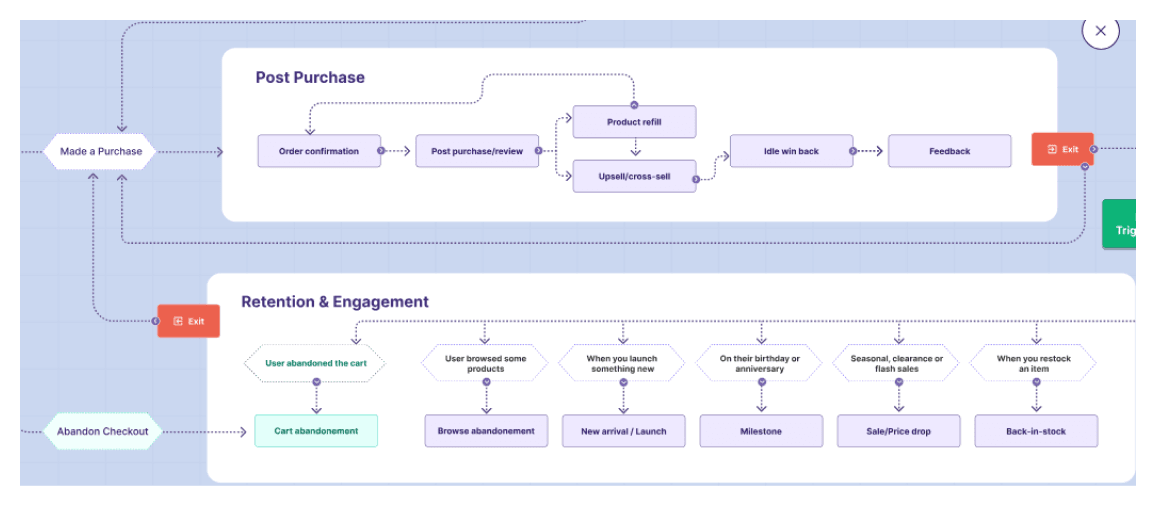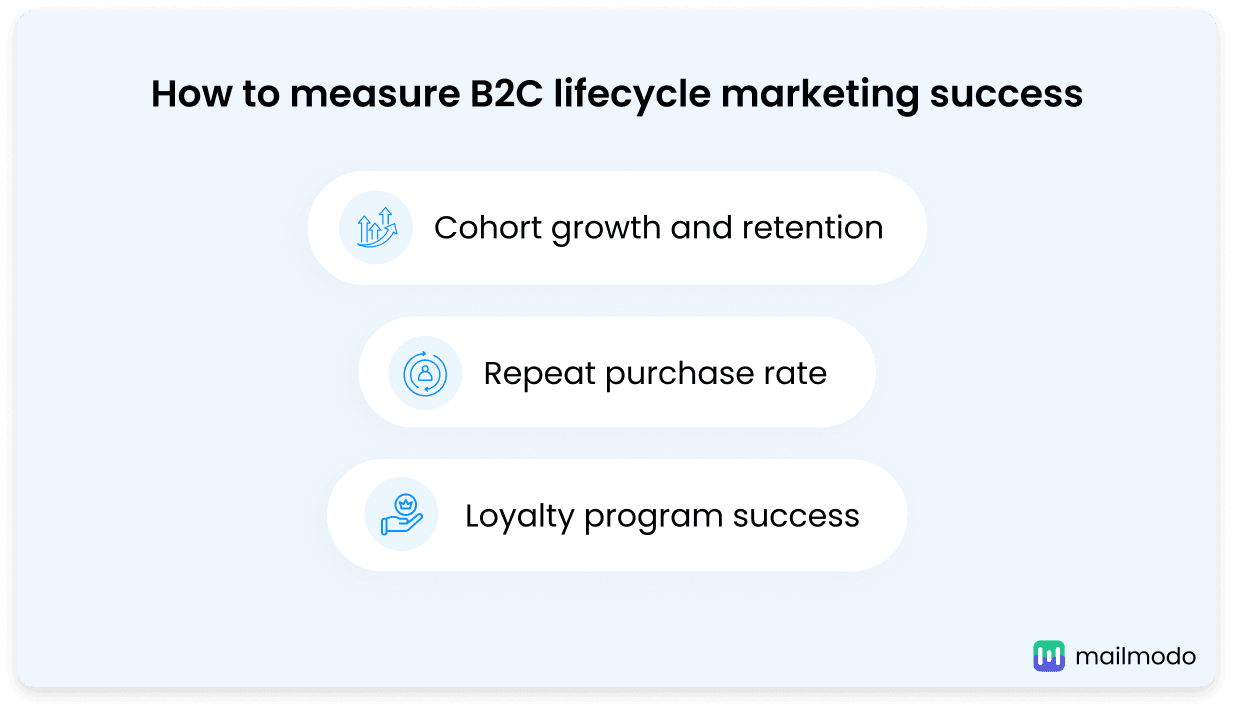A quick understanding of B2C lifecycle marketing
The B2C customer journey is all about creating quick, meaningful connections with individual customers (rather than businesses), to drive purchases and inspire repeat business.
Imagine a potential customer spots social media posts of your brand about a stylish pair of shoes and they click and visit the product page. In this case, there could be two outcomes -
- The customer directly makes a purchase.
- The customer is intrigued but not yet ready to buy and leaves the page.
If the user doesn’t make the purchase and leaves in the middle, you can encourage the user to sign up for your newsletter before the user leaves so that you can nurture the user with follow-up emails. You can also send exclusive discounts to the user when they complete the purchase.
Upon completing the purchase, you can send the customer a confirmation email with tracking details or information about their purchase.
Later, you can use the customer’s data to follow up with personalized offers and updates. You could also provide them with styling tips to maintain engagement, encourage them to follow and subscribe to your social media, and encourage them to shop from you again. You can also reward them for referring you to their friends.
Take a look at this other example of multiple touchpoints in a customer’s lifecyle:

B2C vs B2B lifecycle marketing
The primary difference between B2C and B2B lifecycle marketing is the target customer. While B2B targets brands and companies, B2C targets individual customers.
Let’s explore some other differences between the two:
| Stage |
B2C |
B2B |
| Awareness and Consideration |
The marketing team aims to capture attention with fast tactics using social media ads and discounts to drive instant engagement. |
Focuses on educational content, such as webinars, white papers, and blog posts, to build trust and address specific business needs over time. |
| Conversion |
Typically faster. Brands offer incentives like discounts and offers along with seamless checkout options. |
May require multiple touchpoints, including demos, proposals, and contract negotiations, each step tailored to highlight long-term value and potential ROI for the customer. |
| Retention and Advocacy |
Brands drive repeat purchases and build advocacy through loyalty programs, tailored recommendations, and consistent social media engagement to keep customers connected. |
Focuses on maintaining strong relationships through dedicated account management, customized support, and demonstrating ongoing value. Advocacy encouraged through referrals. |
Who can use B2C lifecycle marketing?
B2C lifecycle marketing can apply to a wide range of businesses and industries where the focus is on engaging directly with individual customers.
Here are some key entities that benefit from B2C lifecycle marketing:
- Ecommerce brands – Online stores that sell products like clothing, electronics, and beauty items, or are in the fast moving consumer goods space.
- Retail stores – Physical stores, especially those with online components like a website or a Google map listing.
- Subscription services – Businesses like streaming services, meal kits, and subscription boxes.
- Travel and hospitality – Airlines, hotels, and tour operators.
- Consumer services – Companies providing services like wellness (gyms, spas), healthcare, education, and events.
Key stages and strategies of B2C lifecycle marketing
B2C lifecycle marketing has 3 key stages. Each stage requires a strategy to ensure the brand ultimately retains customers, and in turn, can boost its growth.
So, let’s take a look at each of the three stages in detail:

Stage 1: Purchase
The purchase stage is where B2C lifecycle marketing kicks off, capturing the customer’s interest and guiding them toward conversion. At this stage, a customer becomes aware of your brand through social media, word of mouth, or other channels, and makes a purchase. It's essential to collect customer data in this stage—like browsing behaviors, preferences, or demographics—to effectively segment your audience for targeted engagement in the later stages.
Here are some strategies you can use at this stage:
Use dynamic email segmentation to categorize users by recent browsing activity, product interests, and purchase intent. This approach ensures each message feels relevant, prompting new customers to take that final step toward completing their purchase.
Send interactive, personalized abandoned cart emails to re-engage customers and encourage them to complete their purchases.
Use retargeting social media ads to engage customers who have already interacted with your website or social media but haven't yet purchased. These will remind potential customers of their initial interest and guide them back to your site, helping them navigate through the sales journey.
Stage 2: Post-purchase stage
The post-purchase stage focuses on deepening the relationship with your customers and turning them into repeat buyers. This is where you nurture loyalty through personalized follow-ups, exclusive offers, and loyalty programs. While the purchase stage is focused on conversion, post-purchase is about maintaining engagement—reminding customers of the value your brand brings, encouraging them to make their next purchase, and fostering a stronger emotional connection. When done right, it turns first-time buyers into loyal supporters who are more likely to become advocates for your brand.
Here are some strategies you can use at this stage:
Send immediate, interactive thank-you emails after the purchase with details about the order like delivery date and delivery traacking.
Send follow-up emails that recommend related products for upselling and cross-selling.
Send exclusive deals like discounts to keep customers engaged.
Send milestone emails like anniversary and birthday emails to make them customers special.
Set up product recommendation emails to target customers to upsell or cross-sell products and make relevant suggestions.
Stage 3: Retention and growth
Retention is the foundation of long-term success in B2C marketing. While post-purchase is about keeping customers engaged, retention focuses on ensuring they remain loyal for the long haul. It’s a cost-effective approach since retaining customers is far less expensive than constantly acquiring new ones. Retention is all about making sure customers feel consistently valued and motivated to return, fostering sustained growth and a strong brand community.
Strategy:
Use automated re-engagement emails with interactive elements to win back customers who haven’t interacted with your brand in a while, reminding them of what they’re missing.
Send engaging, interactive feedback forms post-purchase to gather insights and demonstrate that you value your customers’ opinions, showing them that their feedback helps improve their experience.
Create engaging, interactive emails that invite new customers to join your loyalty program offering rewards and perks that encourage repeat purchases and foster deeper brand loyalty.
Keep loyal customers engaged with exclusive perks, personalized email offers, and event-based emails, ensuring they feel connected to your brand and appreciated for their continued support.
How to measure B2C lifecycle marketing success

Measuring B2C lifecycle marketing success means focusing on metrics that show customer growth and loyalty. Tracking key KPIs reveals how well each stage engages and retains customers, helping identify areas for improvement. Here are some key factors you can look at to measure the success of your B2B lifecycle marketing efforts.
Cohort growth and retention
Cohort analysis is invaluable for tracking how well new customers stay engaged over time. By grouping customers based on acquisition month, geography, or preference of marketing channel, you can observe how specific strategies impact each cohort. Higher cohort growth and retention rates indicate that customers find a good value proposition and are more likely to stay loyal.
Repeat purchase rate
Tracking the repeat purchase rate will help you reveal how many customers are returning to buy again. This is a crucial indicator of customer satisfaction and loyalty. Breaking down repeat purchases by geography or customer segment can help you identify high-performing markets or audiences that may benefit from targeted marketing campaigns.
Loyalty program success
Brands with loyalty programs can look at enrollment rates, engagement levels, and the frequency of redemptions or points usage. Analyzing how loyalty members interact with the brand compared to non-members can provide insights into the program’s impact on retention and repeat purchases.
In addition to these, you can benefit from measuring other valuable metrics like -
How to build your B2C martech for lifecycle marketing
To achieve optimum results with lifecycle marketing, your B2C brand can benefit from building an effective marketing technology (martech) stack. A well-integrated martech setup will enable your brand to manage the different stages of the customer journey smoothly, while leveraging data to build personalized and engaging customer experiences. While creating your martech stack, here are 2 key points to be mindful of:
Set up a CRM
A powerful customer relationship management (CRM) tool is the foundation of any successful B2C lifecycle marketing strategy. With the CRM, you can keep customer data centralized. By storing essential details like demographics, purchase history, interactions, and communication preferences, you can create unique, personalized content to target individual customers and effectively engage them.
Leverage automation
Marketing automation tools can transform how your brand approaches B2C lifecycle marketing. You can automate repetitive tasks using email marketing tools, SMS marketing tools and in-app notitfications. Email marketing tools allow you to send follow-up emails, abandoned cart emails, and even set up customer journeys and drip campaigns. Other tools also allow you to send SMS, and in-app messages in a timely and personalized way.
Leveraging Mailmodo to create an optimum B2C lifecycle marketing strategy
Mailmodo is an all-in-one email marketing tool that you can use to create, send, automate and personalize emails and optimize your overall B2C lifecycle marketing strategy through email marketing.
Mailmodo also offers other features that you can use to further optimize your marketing efforts. Here are some things you can do with Mailmodo:
- Segment your customers in real time using dynamic segmentation.
- Personalize emails to send content that resonates with your audience.
- Set up automated emails based on various triggers like abandoning of the cart.
- Set up automated birthday and anniversary emails.
- Send emails at the right time with send time optimization.
- A/B test your emails so you know what resonates best with your customers.
- Create and send interactive emails within minutes for higher engagement.
- Create customer journey workflows using a visual journey builder.
Create and send AMP emails without coding in minutes
Takeaways
In today’s competitive market, B2C lifecycle marketing is vital for brands aiming to build lasting customer relationships. By focusing on each stage of the customer journey, brands can create personalized experiences that drive repeat business, boost loyalty, and fuel growth. A strong martech stack—complete with CRM, automation, and communication tools—helps teams understand customer needs, optimize engagement, and ensure consistent brand presence.
To measure effectiveness, track KPIs like cohort growth, repeat purchases, and loyalty engagement, and refine strategies based on these insights. So start your B2C lifecycle marketing journey today and watch your brand grow to newer heights.














